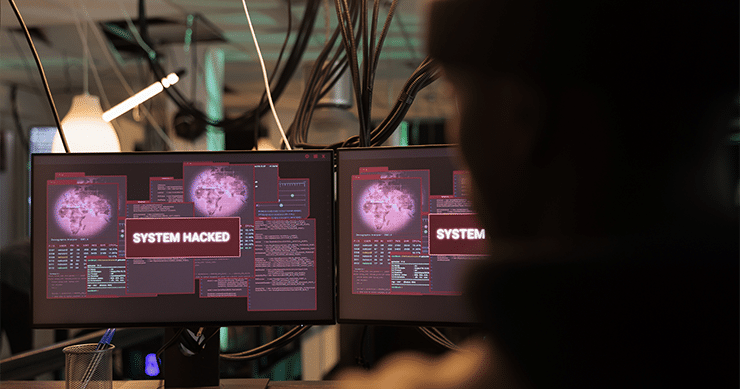Our clients often ask, “What is the difference between vulnerability scanning and penetration testing?” It’s a question that deserves attention, not only because of its frequency but also due to its critical role in shaping an organization’s cybersecurity strategy. Understanding the differences between these two assessments and when to employ each is essential in fortifying digital defenses and mitigating potential threats.

Vulnerability Scans
A vulnerability scan systematically examines IT systems, targeting known security weaknesses. There are two primary categories of vulnerability scans:
- IT Infrastructure Vulnerability Scans: Typically conducted by IT or cybersecurity teams, these scans scrutinize internal IT systems. The scope encompasses networking equipment, file servers, individual computers, peripheral devices, IoT devices, critical applications, and internal processes.
- Application or Website Vulnerability Scans: These scans are the domain of development operations (DevOps) or development security operations (DevSecOps) professionals. They focus on software libraries, APIs, and supply chain components to uncover known vulnerabilities.
Vulnerability scanning is an automated process that uses a vulnerability scanner tool to identify known vulnerabilities and missing patches within a network or application. It is an initial assessment of an organization’s vulnerabilities without actively attempting to breach its defenses.
Features and Benefits:
- Systematic Scanning: Vulnerability scanning employs automated tools and methodologies to scan an organization’s entire digital infrastructure thoroughly. This systematic approach ensures that known vulnerabilities are identified.
- Scoring Severity: Vulnerability scanners often assign severity scores to identified vulnerabilities based on industry-standard metrics like the Common Vulnerability Scoring System (CVSS). These scores quantify the level of risk associated with each vulnerability, considering factors like exploitability, impact, and ease of remediation.
- Quantifiable Metrics: Through vulnerability scanning, organizations can gather quantitative data, such as severity scores and their potential impact. This data can then be used to calculate risk metrics, such as the overall risk score or the organization’s exposure to different threats.
- Comparison Over Time: By regularly conducting vulnerability scans, organizations can track changes in their security posture over time. They can measure improvements by observing how the number and severity of vulnerabilities change, providing evidence of the efficiency of security controls.
Penetration Tests
Penetration testing is a process that involves mimicking a genuine cyberattack on a system or network to assess its security and ability to withstand such threats. Typically conducted by ethical hackers, this process employs various tools and strategies to capitalize on vulnerabilities identified through scanning or similar approaches. A common variant is the black box penetration test, which scrutinizes an organization’s external IT infrastructure. This includes firewalls, web servers, web applications, gateways, and VPN servers. Penetration tests are conducted without prior knowledge of the system.
Penetration testing confirms the adequacy of your security controls, measures the consequences and potential dangers of a security breach, and offers suggestions for enhancement. Penetration testing is sometimes called white hat or ethical hacking because it involves granting “good guys” permission to attempt to breach an organization’s system defenses to understand potential attacker strategies.
Features and Benefits
- Manual Testing: Penetration tests involve human testers who mimic the actions of potential attackers. They actively attempt to exploit vulnerabilities to gain unauthorized access. This manual approach allows testers to adapt and explore complex attack paths that automated scans might miss.
- Exploit Verification: Penetration testers attempt to exploit vulnerabilities to determine if they can be successfully leveraged to compromise systems or data. This verification confirms the actual impact of vulnerabilities.
- Custom Testing: Testers can customize their approach to focus on specific assets, applications, or attack vectors based on the organization’s unique environment and concerns.
- Scenario-Based Testing: Organizations can request penetration tests that emulate specific threat scenarios, such as a data breach or insider threat, to evaluate their readiness and response capabilities.
- Contextual Understanding: Testers can provide context around vulnerabilities, explaining how they could be chained together to escalate an attack, which is often missing in vulnerability scan reports.
Choosing Between Penetration Testing and Vulnerability Scanning
The decision between vulnerability scans and penetration tests hinges on the desired outcome:
- Vulnerability Scans: Employed to scan infrastructure and uncover established vulnerabilities. These are valuable for routine checks, can be swiftly executed by less experienced personnel, and are crucial for detecting known weaknesses. However, they fall short in determining exploitability and potential damage.
- Penetration Tests: Ideal for exploring known vulnerabilities to validate their exploitability and assess the potential harm resulting from exploitation. Penetration tests can also reveal security gaps that are not classified as vulnerabilities. They provide a deeper understanding of an organization’s exposure to risks.
Start Getting Value With
Centraleyes for Free
See for yourself how the Centraleyes platform exceeds anything an old GRC
system does and eliminates the need for manual processes and spreadsheets
to give you immediate value and run a full risk assessment in less than 30 days
Vulnerability Scanning vs. Penetration Testing: Understanding the Differences
Assessment Methodology
Vulnerability scans primarily rely on automated tools, making them accessible for IT and security teams to perform periodic or on-demand assessments. Penetration tests often necessitate external engagement with third-party vendors or managed security service providers (MSSPs) featuring pen-testing expertise. Skilled ethical hackers employ their expertise to assess systems, employing hacking tools as required.
Frequency
Vulnerability scans are typically performed quarterly, with additional scans after significant infrastructure changes. Some organizations, driven by stringent compliance requirements, conduct scans even more frequently. Compliance standards, such as the PCI Data Security Standard (PCI DSS) and HIPAA vulnerability scan requirements, often dictate scan frequency.
In contrast, penetration tests are less common, with many organizations opting for annual external tests. Advanced organizations, especially those with internet-accessible systems or prior vulnerabilities, may conduct 2-4 tests annually.
Internal or External
Vulnerability scans encompass both internal and external systems, but they are predominantly used for internal assessments. Penetration tests, conversely, focus on externally accessible assets, simulating cyberattackers’ perspectives. However, they can also be conducted internally to replicate scenarios involving compromised credentials or comprehensive testing.
Time Investment
Vulnerability scans are relatively quick, often completed within hours. However, the duration varies based on the number and complexity of systems involved.
Penetration tests demand more time, with a typical test spanning weeks. Comprehensive testing can extend over several months, particularly for multinational organizations with diverse assets.
Accuracy of Results
Vulnerability scans frequently report vulnerabilities, some of which may be false positives. These scans may also detect true positives with negligible associated risk. Therefore, each finding requires validation and appropriate action.
Penetration tests, on the other hand, generally yield zero false positives. The testing process rigorously verifies exploitability, confirming that an attacker can access protected data or disrupt operations. However, false negatives can occur, with both vulnerability scans and penetration tests potentially overlooking vulnerabilities.
Detection of Zero-Days
Penetration tests can uncover zero-day vulnerabilities and previously unknown weaknesses, whereas vulnerability scanning relies on a database of known vulnerabilities.
The Scope of Assessment
Vulnerability scans cast a wide net, covering all relevant infrastructure elements within the tool’s capabilities. They can scan for tens of thousands of vulnerabilities but are limited to known vulnerabilities programmed into the scanner.
Penetration tests tend to have a narrower scope due to budget constraints, time limitations, and tester expertise. They focus on the most likely vulnerable systems and vulnerabilities, possibly missing other weaknesses.
Different Prices
Vulnerability scans are relatively cost-effective, with expenses primarily tied to tool costs and the time IT or security teams invested for installation, configuration, maintenance, usage, and analysis.
Penetration tests, in contrast, are costlier. They often require external vendors with highly trained penetration testing professionals. Nonetheless, organizations can control pentest costs through careful preparation and scope management.
Putting it All Together
Both vulnerability scans and penetration tests deliver substantial value to organizations. Vulnerability scans identify weaknesses, aiding in their validation, categorization, prioritization, and mitigation. Penetration tests, on the other hand, provide critical validation by verifying exploitability and assessing potential damage. They go beyond identifying vulnerabilities, and uncovering security gaps and weaknesses that may not be classified as vulnerabilities. Effective pentests enhance system security, minimizing opportunities for malicious attacks.
To answer the question, “What is the difference between pen tests and vulnerability scans?”, we’ve compiled the following table to clarify their distinct features.
Comparison of Vulnerability Scans and Penetration Tests
| Aspect | Vulnerability Scans | Penetration Tests |
| Use Case | Employed for examining system infrastructure and detecting established vulnerabilities. | Used to investigate identified vulnerabilities, validate exploit potential, evaluate potential harm, or uncover non-vulnerability exposures in critical systems. |
| Methodology | Mainly tool-centric and often automated in execution. | Driven by ethical hackers or pentesters, incorporating tools as needed during the testing process. |
| Frequency | Typically carried out quarterly for vulnerability assessments, with additional scans post-significant infrastructure changes. | Generally conducted annually for external penetration tests. |
| Execution Context | Conducted in-house. | Primarily performed externally. |
| Duration | Completed within hours, although larger-scale infrastructures may necessitate days. | Typically, it extends over weeks, with comprehensive assessments potentially spanning months. |
| False Positives | Regular occurrence | Virtually absent of false positives, given penetration tests confirm the risk of exploitation. |
| Extent of Assessment | Covers all applicable infrastructure elements, delimited solely by the capabilities of scanning tools. | Scope tends to be constrained by budgetary constraints, time restrictions, and available resources. |
| Cost Implications | Costs generally range from moderate to low, encompassing expenses for tools and IT security resources across installation, configuration, maintenance, utilization, and analysis. | Penetration test costs are relatively high, frequently involving external service providers featuring highly skilled penetration testing professionals. |
Centraleyes offers a comprehensive risk management platform that enables continuous risk monitoring and reporting, allowing organizations to focus on strengthening their security posture. Schedule a demo today to discover how Centraleyes can help improve your cyber resilience and protect valuable data and systems.
Start Getting Value With
Centraleyes for Free
See for yourself how the Centraleyes platform exceeds anything an old GRC
system does and eliminates the need for manual processes and spreadsheets
to give you immediate value and run a full risk assessment in less than 30 days





